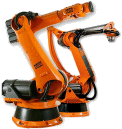
The TX-0, for Transistorized Experimental computer zero, but affectionately referred to as tixo, was an early fully transistorized computer and contained a then-huge 64K of 18-bit words of magnetic core memory. Construction of the TX-0 began in 1955 and ended in 1956. It was used continually through the 1960s at MIT. The TX-0 incorporated around 3600 Philco high-frequency surface-barrier transistors, the first transistor suitable for high-speed computers. The TX-0 and its direct descendant, the original PDP-1, were platforms for pioneering computer research and the development of what would later be called computer "hacker" culture.
Computer magazines are about computers and related subjects, such as networking and the Internet. Most computer magazines offer advice, some offer programming tutorials, reviews of the latest technologies, and advertisements.

Automation is the technology by which a process or procedure is performed with minimal human assistance. Automation or automatic control is the use of various control systems for operating equipment such as machinery, processes in factories, boilers and heat treating ovens, switching on telephone networks, steering and stabilization of ships, aircraft and other applications and vehicles with minimal or reduced human intervention.
In computer engineering, a logic family may refer to one of two related concepts. A logic family of monolithic digital integrated circuit devices is a group of electronic logic gates constructed using one of several different designs, usually with compatible logic levels and power supply characteristics within a family. Many logic families were produced as individual components, each containing one or a few related basic logical functions, which could be used as "building-blocks" to create systems or as so-called "glue" to interconnect more complex integrated circuits. A "logic family" may also refer to a set of techniques used to implement logic within VLSI integrated circuits such as central processors, memories, or other complex functions. Some such logic families use static techniques to minimize design complexity. Other such logic families, such as domino logic, use clocked dynamic techniques to minimize size, power consumption and delay.

The LGP-30, standing for Librascope General Purpose and then Librascope General Precision, was an early off-the-shelf computer. It was manufactured by the Librascope company of Glendale, California, and sold and serviced by the Royal Precision Electronic Computer Company, a joint venture with the Royal McBee division of the Royal Typewriter Company. The LGP-30 was first manufactured in 1956, at a retail price of $47,000, equivalent to $440,000 in 2019.

The TRADIC was the first transistorized computer in the USA, completed in 1954.

The Electrologica X1 was a digital computer designed and manufactured in the Netherlands from 1958 to 1965. About thirty were produced and sold in the Netherlands and abroad.

Elliott Brothers (London) Ltd was an early computer company of the 1950s–60s in the United Kingdom. It traced its descent from a firm of instrument makers founded by William Elliott in London around 1804. The research laboratories were originally set up in 1946 at Borehamwood and the first Elliott 152 computer appeared in 1950.
V850 is the trademark name for a 32-bit RISC CPU architecture of Renesas Electronics for embedded microcontrollers, introduced in the early 1990s by NEC and still being developed as of 2018.

The transistor count is the number of transistors in an electronic device. It typically refers to the number of MOSFETs on an integrated circuit (IC) chip, as all modern ICs use MOSFETs. It is the most common measure of IC complexity. The rate at which MOS transistor counts have increased generally follows Moore's law, which observed that the transistor count doubles approximately every two years.

The Elliott 803 is a small, medium-speed transistor digital computer which was manufactured by the British company Elliott Brothers in the 1960s. About 211 were built.

A transistor computer, now often called a second generation computer, is a computer which uses discrete transistors instead of vacuum tubes. The first generation of electronic computers used vacuum tubes, which generated large amounts of heat, were bulky and unreliable. A second generation of computers, through the late 1950s and 1960s featured circuit boards filled with individual transistors and magnetic core memory. These machines remained the mainstream design into the late 1960s, when integrated circuits started appearing and led to the third generation computer.
Autonetics was a division of North American Aviation that produced various avionics but is best known for their inertial navigation systems used in submarines and intercontinental ballistic missiles. Its 188-acre facility in Anaheim, California, with 36,000 employees, was the city's largest employer. Through a series of mergers, Autonetics is now part of Boeing.

GEC Computers Limited was the computer manufacturing company under the GEC holding company.
Philco was one of the pioneers of transistorized computers. After the company developed the surface barrier transistor, which was much faster than previous point-contact types, it was awarded contracts for military and government computers. Commercialized derivatives of some of these designs became successful business and scientific computers. The TRANSAC Model S-1000 was released as a scientific computer. The TRANSAC S-2000 mainframe computer system was first produced in 1958, and a family of compatible machines, with increasing performance, was released over the next several years.
The Clary DE-60 was an early transistorized digital computer made by Clary Corporation. It was a compact (desk-sized) general-purpose computer intended for both scientific and business applications. It operated on 18-digit binary coded decimal words used fixed-point arithmetic. Main memory was a 32-word magnetic drum memory. Input and output devices included a console keyboard, printer, paper tape and punched card system. For programming, the system used sequential instructions from the keyboard and plug-boards. Custom modules for trigonometric and other functions could be installed.
The PB 250 was a general-purpose computer introduced in 1960 by the Packard Bell Corporation.









